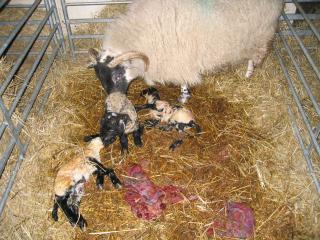Chlamydial infection of sheep an infectious cause of prenatal lamb death
Published on 26 January 2011 in Sustainability and Communities
, Food, health and wellbeing
Introduction
Chlamydial infection of sheep is the single largest infectious cause of prenatal lamb death in the UK. The disease is a large animal welfare issue costing the UK farming industry tens of millions of pounds per annum. Moreover the infection can be spread to humans and is potentially life threatening to pregnant women.
The species of Chlamydia which causes the disease is called Chlamydophila abortus (C. abortus). The first sign of infection is often the appearance of dead or weak lambs in addition to visibly diseased afterbirth and a discharge of infected fluid which can last for several days meaning the ewe remains a potential source of spread of the disease for some time.
The spread of the disease is difficult to control as once an animal is infected with the organism the infection becomes silent (latent). This can be a concern when buying in new animals and great care needs to be taken when sourcing in replacement stock. Once in a flock the disease is difficult to eradicate and while initially only one or two animals may lose their lambs during an initial season the ease of transmission (and difficulty of diagnosing infected animals) may eventually lead to a storm of lamb losses in which up to 30% of ewes are affected. Antibiotic use may reduce losses in the midst of a lambing season however currently the most effective means of controlling the disease is through the use of vaccination.
Key Points
The only vaccines currently available in the UK are based upon live weak strain of the organisms. Vaccination has reduced the incidence of the disease but even with vaccine use some animals may still lose their lambs nonetheless. There have been additional problems with the current vaccines as they have to be administered before the breeding season and in recent years supplies have been restricted at this time of year due to problems with manufacture. Furthermore the vaccines in use today may cause lamb loss in some animals and cannot be handled by pregnant women or individuals with a poor immune system as it may cause illness in these people.
Detection of infected animals is only accomplished by analysis of the dead lambs and afterbirth or a blood test after the loss of a lamb. There is no way currently of detecting infected animals unless they have previously aborted so unless farmers buy replacements from known clean flocks they risk introducing the disease onto their farm.
Research Undertaken
Current research at Moredun has focussed upon the use of cutting edge techniques to increase our understanding of the organism and how it interacts with the host. These allow us not only to identify novel targets for the development of diagnostic techniques and vaccine design but also inform future management strategies for the control of the disease
Moredun is a world-leader in understanding the interactions between the ewe and the organism that lead to lamb death, developing and using novel reagents to investigate the molecules of the sheep immune system and identify those that cause damage to the foetus and placenta.
Vaccination against
C. abortus while reducing the incidence of disease does not stop it and it had been assumed that this was due to the presence of a silent infection in the ewe prior to vaccination. Previously distinguishing the presence of a field-strain from the vaccine strain was a difficult, time consuming and laborious procedure. Recently using cutting-edge molecular techniques scientists at Moredun, in conjunction with collaborators at SAC and the French Agency for Food, Environmental and Occupational Health and Safety (ANSES) (
http://www.anses.fr/index.htm) identified the presence of the current vaccine strain in some of the cases of chlamydial infection in Scotland, implicating the vaccine in the lamb death.
Policy Implications
Chlamydial infection of sheep is an endemic disease throughout the UK and in most sheep breeding countries. Its costs both in terms of economic losses and animal welfare are high and represent a high proportion of reproductive wastage to the sheep industry.
Current strategies of control rely in many cases upon vaccination with a live vaccine that may cause abortion. These results demonstrate the need for the continued development of new diagnostic techniques, the monitoring of existing vaccines and the need for the development of potentially safer next generation vaccines in the agricultural industry.
Author
Dr Nick Wheelhouse nick.wheelhouse@moredun.ac.uk
Topics
Sustainability and Communities
, Food, health and wellbeing
Comments or Questions








